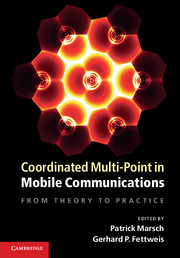Book contents
- Frontmatter
- Contents
- List of Contributors
- Acknowledgements
- List of Abbreviations
- Nomenclature and Notation
- Part I Motivation and Basics
- Part II Practical CoMP Schemes
- Part III Challenges Connected to CoMP
- Part IV Performance Assessment
- 13 Field Trial Results
- 14 Performance Prediction of CoMP in Large Cellular Systems
- Part V Outlook and Conclusions
- References
- Index
13 - Field Trial Results
from Part IV - Performance Assessment
Published online by Cambridge University Press: 05 August 2012
- Frontmatter
- Contents
- List of Contributors
- Acknowledgements
- List of Abbreviations
- Nomenclature and Notation
- Part I Motivation and Basics
- Part II Practical CoMP Schemes
- Part III Challenges Connected to CoMP
- Part IV Performance Assessment
- 13 Field Trial Results
- 14 Performance Prediction of CoMP in Large Cellular Systems
- Part V Outlook and Conclusions
- References
- Index
Summary
In this chapter, we finally provide field trial results for different CoMP schemes discussed in this book. While Section 13.1 observes the performance of successive interference cancelation (SIC) algorithms and uplink macro diversity in laboratory and outdoor drive tests, Section 13.2 provides results on a large-scale field trial in Dresden, where two terminals were moved within a setup of 16 base stations, and the gain of uplink joint detection is assessed. Sections 13.3 and 13.4 then present two slightly different implementations of downlink joint transmission CoMP, where the former puts a primary focus on various challenges encountered, while the latter section discusses an evaluation methodology that enables to predict downlink CoMP performance over larger areas. The chapter is concluded with a review on the lessons learnt through field trial implementation and test in Section 13.5.
Real-time Implementation and Trials of Advanced Receiver and Uplink CoMP Schemes
In this section, field trial activities connected to uplink CoMP schemes and advanced receiver algorithms are described. These new features are promising methods to increase performance for LTE-A networks and have been implemented in a Bell Labs eNodeB prototype. In a first step, an uplink (UL) successive interference cancelation (SIC) algorithm is considered in a single-cell scenario. Simulations and lab tests are used to select the best algorithm approach and to optimize involved parameters. To show the feasibility and to assess the advantages of such a SIC receiver algorithm in a real deployment scenario, field trials in the EASY-C research test bed in Dresden [I+09] have been conducted.
- Type
- Chapter
- Information
- Coordinated Multi-Point in Mobile CommunicationsFrom Theory to Practice, pp. 313 - 366Publisher: Cambridge University PressPrint publication year: 2011

